West Bengal police massacre protesters
Eva Cheng
20 April 2007
With 80 million inhabitants, West Bengal is the fourth most populous state in India. It has been ruled by the Communist Party of India (Marxist)-led Left Front (LF) coalition for three decades. This government, however, has regularly used police repression against workers and peasants to defend big-business interests.
Last month, for example, West Bengal Chief Minister Buddadeb Bhattacharjee, who is a member of the CPI(M) political bureau, sent 4000 heavily armed police to suppress peasant protests against the LF government’s plans to seize 4000 hectares of farmland in the Nandigram area, 150 kilometres southwest of Kolkata (Calcutta), for a Special Economic Zone to be run by the Indonesian-based Salim Group. On March 14, police opened fire on peasant protesters, killing 14 of them and wounding at least 75 others.
Bhattacharjee’s immediate public response to the massacre was to insinuate that the peasant protesters had been stirred up by “outsiders” such as the “Naxalites” and Trinamool Congress, West Bengal’s right-wing opposition party. “Naxalites” is a term used in the Indian corporate media to refer to those originally Maoist-inspired left groups that sprang from a 1967 peasant struggle in the Naxalbari area of northern West Bengal.
The peasant protests in Nandigram have attracted broad support among working people and intellectuals not only in West Bengal, but across the rest of India. Left-wing historians Romilla Thapar, Tanika Sarkar, Sumit Sarkar, novelist Arundhati Roy and journalist Praful Bidwai have all protested against the CPI(M)’s anti-peasant policies. Sumit and Tanika Sarkar, winners of West Bengal’s highest literary honour, returned their awards to the West Bengal government in protest.
In a manifestation of deep popular anger at this massacre, working people across West Bengal staged a general strike on March 16. Protesters blockaded roads and railways throughout the state. In Kolkata, the capital of West Bengal, schools and colleges were closed and at government offices only 20-25% of employees reported for work. Police mobilised by the LF government arrested 1400 people across West Bengal.
The CPI(M)’s pro-business leanings are unmistakable. When workers’ strikes were brewing in West Bengal last April, Bhattacharjee lectured that “it’s not only the management’s responsibility alone to run industry, but labourers should also co-operate so that disputes are settled through discussions”.
Defending police repression of striking workers, Bhattacharjee declared: “We have acted firmly by calling in police when the unions turned militant at Bata and a Pepsi factory.”
At a press conference in early April 2006, Bhattacharjee said, “we are not practising socialism”, adding that “since we are practical, we know it is wise to be capitalist at the moment
when the whole world is wooing capitalism”. Even more explicity, he declared, “we are trying to be friendly with the capitalists”.
In an interview printed in the November 16, 2005 Hindu newspaper, Bhattacharjee seemed to regret some of his government’s previous more pro-working people policies, saying: “We did commit wrong things in the past. There were investors really afraid of trade unions here. But things have changed … I am in constant touch with our senior trade union leaders and keep telling them that it is now a different situation … I tell [them] they must behave. If you don’t behave companies will close …”
The CPI(M)’s pro-capitalist, anti-peasant politics are not new. When the peasant uprising in Naxalbari began in 1967 under the revolutionary leadership of some CPI(M) members, it was brutally suppressed by the CPI(M)-led LF government. This sparked a rebellion within the CPI(M)’s ranks and supporters across India, leading to a major split the following year. The dissenters launched the new Communist Party of India (Marxist-Leninist) in 1969.
Clues on how the CPI(M) justifies its ordering of police repression against working people was already revealed a month before the May 25, 1967, Naxalbari anti-landlord peasant uprising. In the April 16, 1967 edition of the CPI(M)'s People’s Democracy weekly, the party’s West Bengal state committee declared that the LF “ministry is formed on the basis of a conglomeration of 14 parties with different politics and ideologies and they are united with the aim of serving the people’s interests. It has to function on the basis of a non-class outlook.”
This “non-class outlook” really means not championing the class interests of West Bengal’s working class and poor peasants against their capitalist exploiters.
During the first six months of the LF government in 1967, more than 60,000 West Bengal workers were sacked by their employers. What was the CPI(M)’s response to this? According to the October 24, 1967 Indian Statesman newspaper, CPI(M) political bureau member Jyoti Basu publicly declared that the trade unions as responsible as the capitalist employers for creating a situation of industrial “disharmony”.
In 1977, the LF government launched a series of land reform measures that ameliorated the desperate situation of many rural labourers. However, the half-hearted nature of these measures resulted in a 2002 audit revealing that, of the 400,000 hectares of land that the government had acquired for redistribution since 1977, only 100,000 hectares had been transferred to peasants.
The June 2002 issue of Liberation, the monthly produced by the Communist Party of India (Marxist-Leninist)-Liberation, reported that while West Bengal’s minimum wage was fixed at about 62 rupees for agricultural labourers, the actual wage was closer to Rs 28-35 plus two kilograms of rice, or less.
Since then the land reform has been undermined by the conversion of farmland to other commercial uses. According to West Bengal land reform minister Abdur Rezzak Molla in 2005, agricultural land in West Bengal was being converted for other uses at the alarming rate of 20,000 hectares a year.
A key source of the CPI(M)’s conversion into a pro-capitalist left-centre party originates from its orientation toward the Indian capitalist class.
The CPI(M) originated in a 1964 split from the Communist Party of India (CPI), a party aligned with the Soviet Communist Party. The split was triggered by the 1960 Sino-Soviet dispute and the 1962 Sino-Indian War, in which those who would later form the CPI(M) took a pro-China position. The CPI(M)’s alignment with the Chinese CP regime came to an end in 1967 when Beijing declared its public support for the Naxalbari rebels.
Like the CPI, the CPI(M) held the view that there was a basis to seek collaboration in government with the “patriotic”, “anti-imperialist” Indian capitalists.
The main difference in political practice between the two parties is that while the CPI has happily participated in governments at the national level with the Indian National Congress party, India’s main big-business party, the CPI(M) has been reluctant to do so.
The CPI(M) regards sections of the rural rich as potential political allies, leading to the party’s alliances with rich peasant-based local parties such as the Rashtriya Janata Dal party in Bihar, Telugu Desam Party in Andhra Pradash and Samajwadi Party in Uttar Pradash. These alliances are a powerful barrier to CPI(M) involvement in organising and mobilising the rural poor.
In the 2004 national elections, the CPI(M) won an average of 42.31% of the votes in the 69 seats it contested, giving it 43 national MPs. Its MPs have played a pivotal role in supporting the Congress-led United Progressive Alliance government, while not joining it. This is despite the fact that the UPA government is pursuing a full-blown, pro-big business program of neoliberal economic measures — privatisation, cuts to social and public services, the dismantling of agricultural price supports, deregulation, and tariff and corporate tax cuts.
In a February 2005 open letter to Venezuelan revolutionary socialist President Hugo Chavez during his visit to West Bengal as a guest of the CPI(M), social activist Gautam Sen wrote that “only three days earlier… elaborate deployment of the muscle power of the state was on display, ready to forcefully evict thousands of poor, marginalised families from their pathetic slum-dwellings. Although combined resistance to this drive eventually forced the authorities to cancel the operation, we would like you to know that this was no isolated event. For several years now, this government has undertaken ruthless and continuous eviction drives across the State and rendered over a lakh [100,000] people homeless.
“Incredible but true, these evictions have been made without any rehabilitation. Not just that; this is the only state government in the whole of India that has boldly announced in so many words — evictions will continue, no rehabilitation will be done, and that is Left Front policy.”
The record of the CPI(M) in West Bengal demonstrates that, just as you can’t judge the content of a book by its cover, you can’t judge a party by its name.
From: International News, Green Left Weekly issue #707 25 April 2007.
सीपीएम की क्रांति
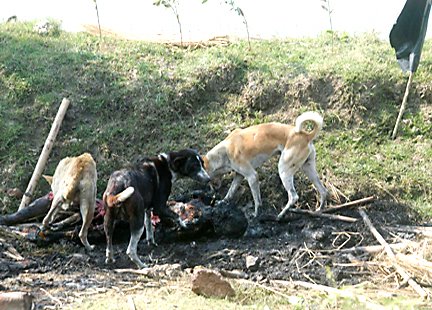
हम एक लोकतंत्र में रह रहे हैं! 14 मार्च को हुई घटना और उसके बाद सीपीएम के बंद के दौरान गायब हुए दो सौ लोगों का अब तक कोई अता-पता नहीं है्. हां। कुछ लाशें हैं जो इलाके में इस हालत में पायी गयी हैं. क्या हम बता सकते हैं कि इन्होंने किस बात की कीमत चुकायी? क्या हम इसको लेकर आश्वस्त रह सकते हं कि हमें भी कभी ऐसी ही कीमत नहीं चुकानी पड़ेगी?
Wednesday, April 25, 2007
Subscribe to:
Post Comments (Atom)
नंदीग्राम पर नयी फ़िल्म
यह फ़िल्म 14 मार्च की घटनाओं के सूक्ष्म विवरण के साथ आयी है.
देखें : नव उदारवाद का नया चेहरा बजरिये नंदीग्राम
देखें : विकास के नाम पर लोगों के उजड़ने की कहानी
उन्होंने मेरे पिता को टुकडों में काट डाला
देखें : न हन्यते
नंदीग्राम में 100 से ज्यादा लोग मारे गये हैं, 200 अब भी लापता हैं. वहां महिलाओं के साथ सीपीएम के कैडरों ने बलात्कार किया. बच्चों तक को नहीं छोड़ा गया है. सीपीएम की इस क्रूरता और निर्लज्जता का विरोध होना चाहिए. हमें नंदीग्राम, सिंगूर और हर उस जगह के किसानों के आंदोलन का समर्थन करना चाहिए, जो अपनी जमीन बचाने के लिए लड़ाई लड़ रहे हैं. यह दस्तावेज़ी फ़िल्म किसानों के इसी संघर्ष के बारे में है. यह फ़िल्म नंदीग्राम के ताज़ा नरसंहार से पहले बनायी गयी थी.
नंदीग्राम में जनसंहार के बाद के द्श्य
यह फिल्म पुलिस द्वारा नंदीग्राम में बर्बर तरीके से की गयी हत्याओं एवं उनकी भयावहता व बर्बरता के बारे में है. इसके कई दृ़श्य विचलित कर देनेवाले हैं.
नंदीग्राम प्रतिरोध्
नंदीग्राम में सरकारी आतंक
देखें : माकपा की गुंडागर्दी
नंदीग्राम में सीपीएम सरकार की पुलिस ने जो बर्बर कार्रवाई की, वह अब खुल कर सामने आने लगी है. यह फ़िल्म उसी बर्बरता के बारे में है. इसके कई दृश्य आपको विचलित कर सकते हैं. आप इसे तभी देखें जब आप वीभत्स दृश्य देख सकने की क्षमता रखते हों. हम खुद शर्मिंदा हैं कि हमें ऐसे दृश्य आपको दिखाने पड़ रहे हैं, पर ये आज की हकीकत हैं. इनसे कैसे मुंह मोडा़ जा सकता है?
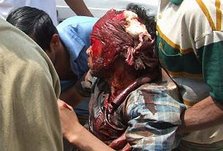
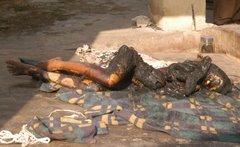
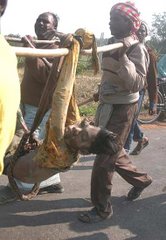
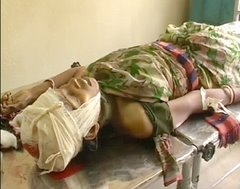

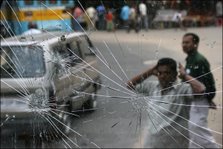
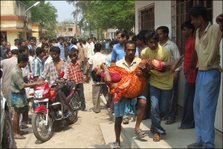

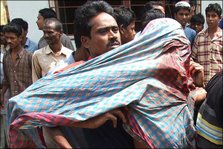


No comments:
Post a Comment